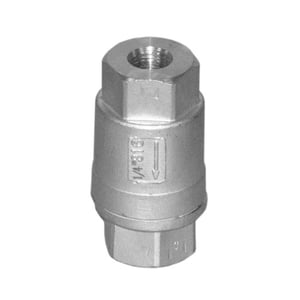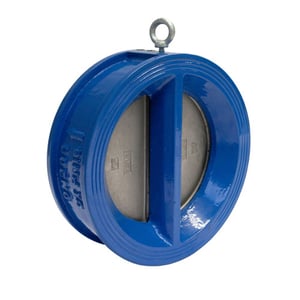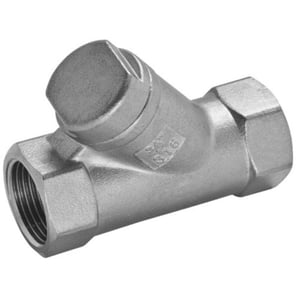What is the best non-return valve?
A non-return valve (NRV), also known as a check valve, is a mechanical device used to allow fluid flow in only one direction. These valves contain a movable element that blocks the flow in the opposite direction, eliminating backflow.
Due to their simple design and few moving parts, non-return valves are extremely reliable and require minimal maintenance. The question is – which type of non-return valve and which material is most suitable for your application?
In this blog, we explain how a non-return valve works, the appropriate materials, suitable applications, and the pros and cons of each type.
Types of non-return valves
Non-return valves enable fluid to flow freely in one direction and then automatically close when fluid flow is reversed. Based on their operational function, check valves are used in various applications, such as to:
- Safeguard the system by preventing fluid backflow.
- Prevent contamination caused by fluid backflow.
- Prevent siphoning action in pipelines.
- Maintain a vacuum seal.
When selecting which valve needs to be installed in your piping system, you need to consider the type of fluid, flow, temperature, debris, system pressure, installation, pipeline size, and available space. Additionally, think about how frequently you need to service it or replace it.
With these factors in mind, choose from the following common types of non-return valves:
Spring-loaded check valve
 The spring-loaded check valve, also known as the disc check valve, consists of a body, disc, guide, and spring. They utilise fluid pressure and a compression spring mechanism to open and close. When the flow stops, the valve automatically shuts, preventing reverse flow.
The spring-loaded check valve, also known as the disc check valve, consists of a body, disc, guide, and spring. They utilise fluid pressure and a compression spring mechanism to open and close. When the flow stops, the valve automatically shuts, preventing reverse flow.
Spring-loaded check valves can be installed in inline systems and in various orientations, including vertical pipelines where fluid flows downwards.
PROS
- Can be installed in any position.
- Reliable operation.
- Low cause of water hammer.
CONS
- The fluid must be free of debris and fibres.
- The valve cannot be serviced in position.
APPLICATIONS
- Plumbing systems
- Irrigation systems
- Industrial processes
- Water treatment systems
You can find stainless steel and brass spring check valves on our website.
Swing Check Valve
 Swing check valves have a radially hinged disc. When the pressure at the valve’s inlet port rises, the radially hinged disc pivots around the hinge and creates an open pathway for fluid to pass through. When the flow reverses, the disc returns to its original position and seals the passage.
Swing check valves have a radially hinged disc. When the pressure at the valve’s inlet port rises, the radially hinged disc pivots around the hinge and creates an open pathway for fluid to pass through. When the flow reverses, the disc returns to its original position and seals the passage.
PROS
- Can be installed horizontally or vertically.
- Can be serviced in place.
- Low cracking pressure.
- An open flow path allows it to handle some debris and solids.
CONS
- Prone to water hammer due to disc impact.
- Not suitable for pulsating flow.
APPLICATIONS
- Sewage systems.
- Water systems.
- Wastewater applications.
You can find stainless steel, brass, and PVC swing check valves on our website.
Wafer Type Check Valve
 Wafer type check valves consist of a thin disc positioned between two flanges in either a single-disc or dual-disc configuration. A single disc is hinged on one side and functions like a swing check valve. The dual-disc type features two spring-loaded plates secured to a central hinge pin.
Wafer type check valves consist of a thin disc positioned between two flanges in either a single-disc or dual-disc configuration. A single disc is hinged on one side and functions like a swing check valve. The dual-disc type features two spring-loaded plates secured to a central hinge pin.
Wafer-type check valves are compact and lightweight, making them ideal for space-saving installations between companion flanges.
PROS
- Cost-effective, especially in large sizes.
- Easy to install and remove for maintenance.
- Compact design.
- Dual disc type can be installed in any position.
CONS
- The fluid must be clean and free of debris.
APPLICATIONS
- HVAC.
- Plumbing systems.
- Irrigation systems.
You can find cast iron and stainless steel double door wafer check valves on our website.
Ball Check Valve
 Ball check valves utilise a ball inside the valve mechanism to open and close it. The two types of ball check valves are known as spring-loaded and free-floating. Free-floating ball check valves are typically employed in low-pressure applications.
Ball check valves utilise a ball inside the valve mechanism to open and close it. The two types of ball check valves are known as spring-loaded and free-floating. Free-floating ball check valves are typically employed in low-pressure applications.
Spring-loaded ball check valves are similar to an in-line check valve but instead of a disc, they utilise a ball. These are designed for high-pressure scenarios.
PROS
- Single moving part.
- Minimal maintenance.
- A fully open flow path.
- Excellent for high solids handling.
- Low cracking pressure.
CONS
- Has a tendency to slam due to the ball’s high inertia and long stroke.
- Water hammer risk, particularly in high-pressure installations.
APPLICATIONS
- Wastewater applications.
You can find PVC ball valves and brass ball valves on our website.
Piston Check Valve
 A piston check valve has an inlet, an outlet, and an internal piston. This operates based on differential pressure across the piston to allow or block the fluid flow. Piston check valves are commonly constructed with globe valve bodies which can result in a pressure drop within the pipeline.
A piston check valve has an inlet, an outlet, and an internal piston. This operates based on differential pressure across the piston to allow or block the fluid flow. Piston check valves are commonly constructed with globe valve bodies which can result in a pressure drop within the pipeline.
PROS
- Can be serviced in place.
- Fast closure time.
- Reliable operation.
- Metal seated versions have high-temperature resistance.
CONS
- Higher pressure drop due to flow path restriction.
- Higher cracking pressure.
APPLICATIONS
- High-pressure applications.
- Often used to protect pumps, boilers, or similar.
You can find stainless steel piston check valves on our website.
Foot Check Valve
 In a foot check valve, a strainer is positioned at the inlet to prevent debris and sand particles from entering. This helps to reduce damage to the valve and ensures consistent system flow. This type of valve is often installed at the intake of the pump suction line in a fluid flow system.
In a foot check valve, a strainer is positioned at the inlet to prevent debris and sand particles from entering. This helps to reduce damage to the valve and ensures consistent system flow. This type of valve is often installed at the intake of the pump suction line in a fluid flow system.
PROS
- Essential on pump intakes to ensure holding of prime.
- The intake screen eliminates debris from entering pipework.
CONS
- Potential pump starvation if blocked by debris.
- Regular maintenance required, particularly in fluid sources with dirt and debris.
APPLICATIONS
- Any pump intake line with fluid level below the pump intake.
- General water and wastewater systems.
- Industrial fluids.
You can find uPVC flanged swing foot valves, uPVC lever swing foot valves, brass and stainless steel foot valves, on our website.
Suitable materials for check valves
Selecting the appropriate valve material depends on several factors. Firstly, it must be compatible with the fluid that flows through the valve. For example, consider if that fluid is aggressive, contains abrasive debris, or is prone to extreme temperatures.
Next, consider the environmental conditions the valve will operate in accounting for exposure to harsh weather or fluctuating temperatures. Finally, factor in the system operating pressure. Various materials are used in the manufacturing of different types of check valves, including:
Stainless steel
Stainless steel is highly resistant to corrosion, chemicals, and extreme temperatures. Usually, stainless steel valves are rated for a broader range of operating temperatures than brass or plastic alternatives. It is known for its strength and durability, making it ideal for industries such as oil and gas, chemical processing, and marine applications.
Brass
Brass is also a durable and corrosion-resistant material suitable for a wide range of applications. It offers strength, withstands high temperatures, and is commonly used in water supply systems and plumbing.
Polyvinyl chloride (PVC)
PVC is a lightweight and cost-effective option often used in water treatment, irrigation, and general-purpose applications.
Polypropylene (PP)
Polypropylene is a cost-effective, rigid, and tough thermoplastic often used in water distribution systems. Unfortunately, polypropylene has poor bonding properties and can be more susceptible to UV degradation, meaning it isn’t suitable for applications of high UV penetration.
Each of these materials offers advantages and disadvantages so we recommend speaking with your supplier and engineer to confirm their compatibility with your system.
Product highlight: PVC industrial swing valves
At Waterworks, our PVC Industrial Swing Non-Return Valves are great for preventing backflow in low-pressure or drainage systems. The access point at the top of the valve allows easy access for cleaning the valve and removing trapped debris. Additionally, the inner section of the valve can be removed and is a replaceable component.
Ultimately, choosing the right check valve will depend on the specific needs and requirements of your piping system, as well as the intended application. If in doubt, reach out to the friendly team at Waterworks or check out our full range of check valves. Download our new brochure to find out more about our PVC Industrial Swing Non-Return Valves.

-1.png)

.png?width=352&name=WW%20best%20valve%20for%20wastewater%20and%20effluent%20(1).png)

.png?width=352&name=Waterworks%20%20PE%20vs%20PVC%20(1).png)